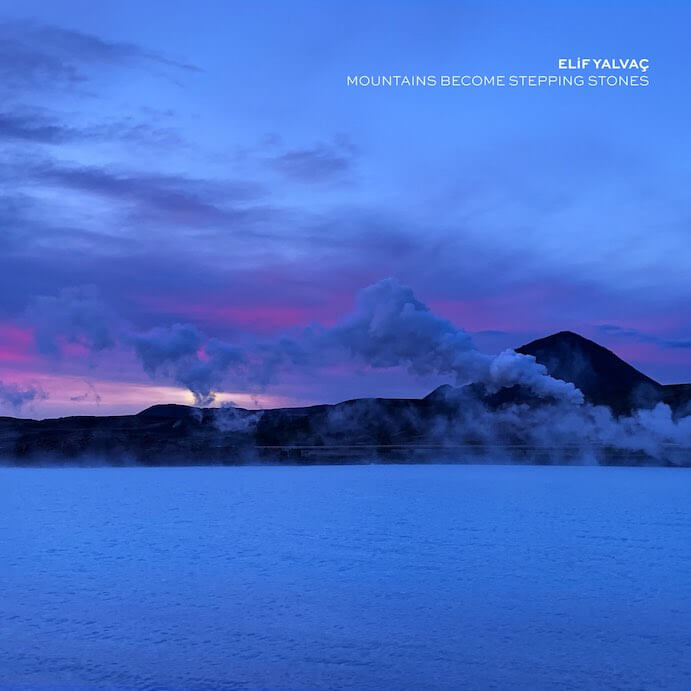Elif Yalvaç grew up in an area of Turkey where, according to her bio, guitars were hard to come by. A self taught player, Yalvaç describes her interest being as much about the variety of sounds she could muster from the instrument as the nature of songwriting. Her sophomore album, Mountains Become Stepping Stones (released December 4, 2020 on NNA Tapes), puts this fascination on display with mesmerizing abandon. Inspired by her travels to Iceland and other Nordic countries, the project is a sort of haunted, wandering journey through washes of sonic texture, field recordings, and electronic sounds. These elements address themes familiar to Yalvaç’s developing canon, including the nature of transformation and the danger, intensity, and raw beauty of the primordial landscapes she has encountered. A very personal and introspective project, Yalvaç describes her new album as “a celebration of individuality and uniqueness. We’re defined by our flaws, and something broken can become even more beautiful.”
Often veiled by heavy filters and noisy effects, guitars echo across broad, reverberant chasms like a weird siren’s song beckoning their discovery, reminiscent of Yalvaç’s own childhood quest to find a guitar. Now possessed of that special treasure, Yalvaç has become a Lady of the Lake, tempting the listener with tones of electric Excalibur. From this nucleus, Yalvaç employs a broad range of synthesizers (including a Game Boy) and field recordings gathered primarily in Iceland to weave her gripping tapestry. Her compositions consist of evolving opposites, gradually shifting from one pole to another by pitting fuzzy glitching electronics and sweeping drones against sparse melodic material and undulating chordal structures.
Sound design being the most prominent motive in her process, Yalvaç’s listener is often left to decode carefully balanced strata of overlapping sonorities. In one instance, something like footsteps crunching on volcanic soil navigates dreamy landscapes, while in another, plucked guitar strings suddenly become percussive strikes on kalimba keys before dissolving into soaring electronic drones and washes of static.
Toward the end of an early cut entitled “Painted in Pitch Black,” swelling clusters vacillate with holographic intensity between sounding like a heaving pipe organ and an enormous tam-tam, leaving one to guess whether they’re hearing either sound at all. Later, “Freak Box” simultaneously suggests a tuning orchestra preparing to perform and a radio dial that has transcended time and space. The listener is guided through spacious atmospheres that ebb and flow with metallic density, like plumes of ash in a darkened sky illuminated from within by slow, silent lightning. Similarly, “Two Compartments” opens with a bluesy riff on an overdriven guitar that briefly recalls stoner-metal tropes before dissolving into a cavernous, industrial din.

Elif Yalvaç–Photo by Michael Bearpark
Turning to myths and legends, “Huginn and Muninn” refers to the ravens that the Norse god Odin employed to gather intelligence from around the realm of Midgard. The sounds of ravens squawking play into a kind of theme and variations through the use of stacked delay and droning synthesizers. As Yalvaç explains, “In some cultures, these birds are sometimes associated with ill or dark things, symbolizing that something bad might happen. To me, however, these are brilliant animals. I have seen more in Iceland than in any other place and they are so beautiful.”
In a literal nod to the natural environment, “Under the Aurora” consists of pop tonalities strummed on the guitar, which glimmer ethereally like the Northern Lights on a dark and starry night. According to Yalvaç, this work was composed after a life-changing experience beneath the magical aurora borealis: “I had some memories in Reykjavik that hurt me, but I picked up an e-bike and cycled for 15 km to a tiny natural footbath hot spring there, where I sat for hours, lost, with my eyes on the skies. I cycled back under the Aurora in the middle of the night.”
The final track, “Kintsugi,” refers to the Japanese art of “golden joinery” (repairing broken pottery with gold-infused lacquer). Sparser than most of the other tracks on the album, the fractured tonalities of the piece convey the meaning of its title with spectral subtlety. Still, after building such a cohesive narrative so tied to the Icelandic wilderness, the shift to an entirely new artistic inspiration (not to mention disparate cultural paradigm) feels a bit abrupt. Even without acknowledging the referenced discipline, the music itself seems to make a stark departure from the awesome majesty of Yalvaç’s established tonal imagery.
Perhaps, in a way, “Kintsugi” signals a step forward that falls in line with Yalvaç’s artistic evolution and personal themes of transformation. There is something to be said for having one foot planted where you are and the other stepping toward where you plan to be. Whichever the case, for Yalvaç the notion serves as a fitting conclusion, as it summarizes a healing journey on which the marks of having been broken form a new and more beautiful whole. If the conclusion of Mountains Become Stepping Stones is that Yalvaç’s Nordic voyage has put her back together, I for one am excited to see where she goes next.
I CARE IF YOU LISTEN is an editorially-independent program of the American Composers Forum, funded with generous donor and institutional support. Opinions expressed are solely those of the author and may not represent the views of ICIYL or ACF.
A gift to ACF helps support the work of ICIYL. For more on ACF, visit the “At ACF” section or composersforum.org.






















